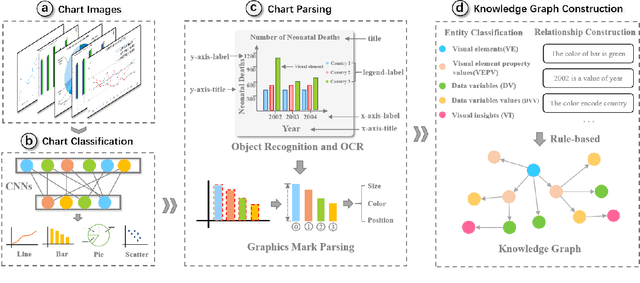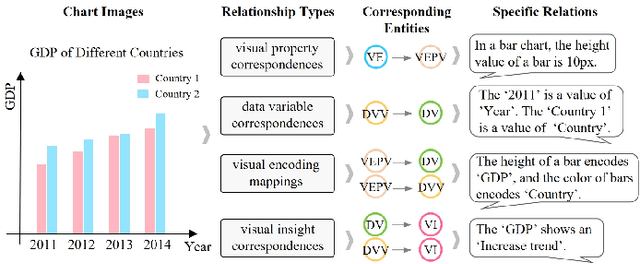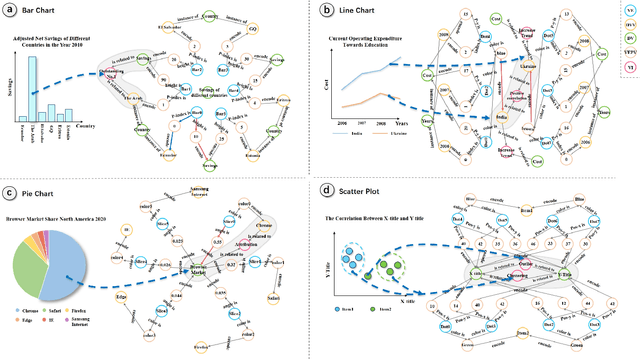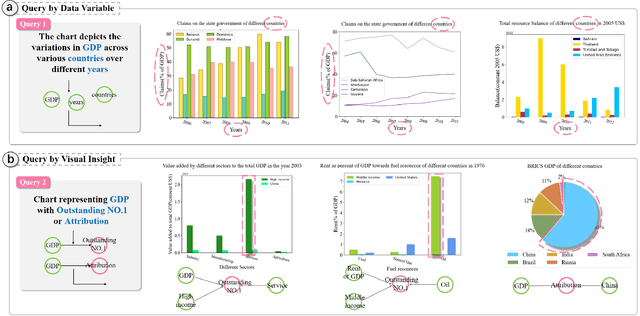Haoxuan Wang
Efficient Multimodal Dataset Distillation via Generative Models
Sep 18, 2025Abstract:Dataset distillation aims to synthesize a small dataset from a large dataset, enabling the model trained on it to perform well on the original dataset. With the blooming of large language models and multimodal large language models, the importance of multimodal datasets, particularly image-text datasets, has grown significantly. However, existing multimodal dataset distillation methods are constrained by the Matching Training Trajectories algorithm, which significantly increases the computing resource requirement, and takes days to process the distillation. In this work, we introduce EDGE, a generative distillation method for efficient multimodal dataset distillation. Specifically, we identify two key challenges of distilling multimodal datasets with generative models: 1) The lack of correlation between generated images and captions. 2) The lack of diversity among generated samples. To address the aforementioned issues, we propose a novel generative model training workflow with a bi-directional contrastive loss and a diversity loss. Furthermore, we propose a caption synthesis strategy to further improve text-to-image retrieval performance by introducing more text information. Our method is evaluated on Flickr30K, COCO, and CC3M datasets, demonstrating superior performance and efficiency compared to existing approaches. Notably, our method achieves results 18x faster than the state-of-the-art method.
STCOcc: Sparse Spatial-Temporal Cascade Renovation for 3D Occupancy and Scene Flow Prediction
Apr 28, 2025Abstract:3D occupancy and scene flow offer a detailed and dynamic representation of 3D scene. Recognizing the sparsity and complexity of 3D space, previous vision-centric methods have employed implicit learning-based approaches to model spatial and temporal information. However, these approaches struggle to capture local details and diminish the model's spatial discriminative ability. To address these challenges, we propose a novel explicit state-based modeling method designed to leverage the occupied state to renovate the 3D features. Specifically, we propose a sparse occlusion-aware attention mechanism, integrated with a cascade refinement strategy, which accurately renovates 3D features with the guidance of occupied state information. Additionally, we introduce a novel method for modeling long-term dynamic interactions, which reduces computational costs and preserves spatial information. Compared to the previous state-of-the-art methods, our efficient explicit renovation strategy not only delivers superior performance in terms of RayIoU and mAVE for occupancy and scene flow prediction but also markedly reduces GPU memory usage during training, bringing it down to 8.7GB. Our code is available on https://github.com/lzzzzzm/STCOcc
UniCombine: Unified Multi-Conditional Combination with Diffusion Transformer
Mar 12, 2025Abstract:With the rapid development of diffusion models in image generation, the demand for more powerful and flexible controllable frameworks is increasing. Although existing methods can guide generation beyond text prompts, the challenge of effectively combining multiple conditional inputs while maintaining consistency with all of them remains unsolved. To address this, we introduce UniCombine, a DiT-based multi-conditional controllable generative framework capable of handling any combination of conditions, including but not limited to text prompts, spatial maps, and subject images. Specifically, we introduce a novel Conditional MMDiT Attention mechanism and incorporate a trainable LoRA module to build both the training-free and training-based versions. Additionally, we propose a new pipeline to construct SubjectSpatial200K, the first dataset designed for multi-conditional generative tasks covering both the subject-driven and spatially-aligned conditions. Extensive experimental results on multi-conditional generation demonstrate the outstanding universality and powerful capability of our approach with state-of-the-art performance.
X-Field: A Physically Grounded Representation for 3D X-ray Reconstruction
Mar 11, 2025Abstract:X-ray imaging is indispensable in medical diagnostics, yet its use is tightly regulated due to potential health risks. To mitigate radiation exposure, recent research focuses on generating novel views from sparse inputs and reconstructing Computed Tomography (CT) volumes, borrowing representations from the 3D reconstruction area. However, these representations originally target visible light imaging that emphasizes reflection and scattering effects, while neglecting penetration and attenuation properties of X-ray imaging. In this paper, we introduce X-Field, the first 3D representation specifically designed for X-ray imaging, rooted in the energy absorption rates across different materials. To accurately model diverse materials within internal structures, we employ 3D ellipsoids with distinct attenuation coefficients. To estimate each material's energy absorption of X-rays, we devise an efficient path partitioning algorithm accounting for complex ellipsoid intersections. We further propose hybrid progressive initialization to refine the geometric accuracy of X-Filed and incorporate material-based optimization to enhance model fitting along material boundaries. Experiments show that X-Field achieves superior visual fidelity on both real-world human organ and synthetic object datasets, outperforming state-of-the-art methods in X-ray Novel View Synthesis and CT Reconstruction.
PixelPonder: Dynamic Patch Adaptation for Enhanced Multi-Conditional Text-to-Image Generation
Mar 09, 2025Abstract:Recent advances in diffusion-based text-to-image generation have demonstrated promising results through visual condition control. However, existing ControlNet-like methods struggle with compositional visual conditioning - simultaneously preserving semantic fidelity across multiple heterogeneous control signals while maintaining high visual quality, where they employ separate control branches that often introduce conflicting guidance during the denoising process, leading to structural distortions and artifacts in generated images. To address this issue, we present PixelPonder, a novel unified control framework, which allows for effective control of multiple visual conditions under a single control structure. Specifically, we design a patch-level adaptive condition selection mechanism that dynamically prioritizes spatially relevant control signals at the sub-region level, enabling precise local guidance without global interference. Additionally, a time-aware control injection scheme is deployed to modulate condition influence according to denoising timesteps, progressively transitioning from structural preservation to texture refinement and fully utilizing the control information from different categories to promote more harmonious image generation. Extensive experiments demonstrate that PixelPonder surpasses previous methods across different benchmark datasets, showing superior improvement in spatial alignment accuracy while maintaining high textual semantic consistency.
Understanding Zero-shot Rare Word Recognition Improvements Through LLM Integration
Feb 22, 2025

Abstract:In this study, we investigate the integration of a large language model (LLM) with an automatic speech recognition (ASR) system, specifically focusing on enhancing rare word recognition performance. Using a 190,000-hour dataset primarily sourced from YouTube, pre-processed with Whisper V3 pseudo-labeling, we demonstrate that the LLM-ASR architecture outperforms traditional Zipformer-Transducer models in the zero-shot rare word recognition task, after training on a large dataset. Our analysis reveals that the LLM contributes significantly to improvements in rare word error rate (R-WER), while the speech encoder primarily determines overall transcription performance (Orthographic Word Error Rate, O-WER, and Normalized Word Error Rate, N-WER). Through extensive ablation studies, we highlight the importance of adapter integration in aligning speech encoder outputs with the LLM's linguistic capabilities. Furthermore, we emphasize the critical role of high-quality labeled data in achieving optimal performance. These findings provide valuable insights into the synergy between LLM-based ASR architectures, paving the way for future advancements in large-scale LLM-based speech recognition systems.
ChartKG: A Knowledge-Graph-Based Representation for Chart Images
Oct 13, 2024



Abstract:Chart images, such as bar charts, pie charts, and line charts, are explosively produced due to the wide usage of data visualizations. Accordingly, knowledge mining from chart images is becoming increasingly important, which can benefit downstream tasks like chart retrieval and knowledge graph completion. However, existing methods for chart knowledge mining mainly focus on converting chart images into raw data and often ignore their visual encodings and semantic meanings, which can result in information loss for many downstream tasks. In this paper, we propose ChartKG, a novel knowledge graph (KG) based representation for chart images, which can model the visual elements in a chart image and semantic relations among them including visual encodings and visual insights in a unified manner. Further, we develop a general framework to convert chart images to the proposed KG-based representation. It integrates a series of image processing techniques to identify visual elements and relations, e.g., CNNs to classify charts, yolov5 and optical character recognition to parse charts, and rule-based methods to construct graphs. We present four cases to illustrate how our knowledge-graph-based representation can model the detailed visual elements and semantic relations in charts, and further demonstrate how our approach can benefit downstream applications such as semantic-aware chart retrieval and chart question answering. We also conduct quantitative evaluations to assess the two fundamental building blocks of our chart-to-KG framework, i.e., object recognition and optical character recognition. The results provide support for the usefulness and effectiveness of ChartKG.
Mamba-YOLO-World: Marrying YOLO-World with Mamba for Open-Vocabulary Detection
Sep 16, 2024Abstract:Open-vocabulary detection (OVD) aims to detect objects beyond a predefined set of categories. As a pioneering model incorporating the YOLO series into OVD, YOLO-World is well-suited for scenarios prioritizing speed and efficiency. However, its performance is hindered by its neck feature fusion mechanism, which causes the quadratic complexity and the limited guided receptive fields. To address these limitations, we present Mamba-YOLO-World, a novel YOLO-based OVD model employing the proposed MambaFusion Path Aggregation Network (MambaFusion-PAN) as its neck architecture. Specifically, we introduce an innovative State Space Model-based feature fusion mechanism consisting of a Parallel-Guided Selective Scan algorithm and a Serial-Guided Selective Scan algorithm with linear complexity and globally guided receptive fields. It leverages multi-modal input sequences and mamba hidden states to guide the selective scanning process. Experiments demonstrate that our model outperforms the original YOLO-World on the COCO and LVIS benchmarks in both zero-shot and fine-tuning settings while maintaining comparable parameters and FLOPs. Additionally, it surpasses existing state-of-the-art OVD methods with fewer parameters and FLOPs.
Distilling Long-tailed Datasets
Aug 24, 2024



Abstract:Dataset distillation (DD) aims to distill a small, information-rich dataset from a larger one for efficient neural network training. However, existing DD methods struggle with long-tailed datasets, which are prevalent in real-world scenarios. By investigating the reasons behind this unexpected result, we identified two main causes: 1) Expert networks trained on imbalanced data develop biased gradients, leading to the synthesis of similarly imbalanced distilled datasets. Parameter matching, a common technique in DD, involves aligning the learning parameters of the distilled dataset with that of the original dataset. However, in the context of long-tailed datasets, matching biased experts leads to inheriting the imbalance present in the original data, causing the distilled dataset to inadequately represent tail classes. 2) The experts trained on such datasets perform suboptimally on tail classes, resulting in misguided distillation supervision and poor-quality soft-label initialization. To address these issues, we propose a novel long-tailed dataset distillation method, Long-tailed Aware Dataset distillation (LAD). Specifically, we propose Weight Mismatch Avoidance to avoid directly matching the biased expert trajectories. It reduces the distance between the student and the biased expert trajectories and prevents the tail class bias from being distilled to the synthetic dataset. Moreover, we propose Adaptive Decoupled Matching, which jointly matches the decoupled backbone and classifier to improve the tail class performance and initialize reliable soft labels. This work pioneers the field of long-tailed dataset distillation (LTDD), marking the first effective effort to distill long-tailed datasets.
PTQ4DiT: Post-training Quantization for Diffusion Transformers
May 25, 2024



Abstract:The recent introduction of Diffusion Transformers (DiTs) has demonstrated exceptional capabilities in image generation by using a different backbone architecture, departing from traditional U-Nets and embracing the scalable nature of transformers. Despite their advanced capabilities, the wide deployment of DiTs, particularly for real-time applications, is currently hampered by considerable computational demands at the inference stage. Post-training Quantization (PTQ) has emerged as a fast and data-efficient solution that can significantly reduce computation and memory footprint by using low-bit weights and activations. However, its applicability to DiTs has not yet been explored and faces non-trivial difficulties due to the unique design of DiTs. In this paper, we propose PTQ4DiT, a specifically designed PTQ method for DiTs. We discover two primary quantization challenges inherent in DiTs, notably the presence of salient channels with extreme magnitudes and the temporal variability in distributions of salient activation over multiple timesteps. To tackle these challenges, we propose Channel-wise Salience Balancing (CSB) and Spearmen's $\rho$-guided Salience Calibration (SSC). CSB leverages the complementarity property of channel magnitudes to redistribute the extremes, alleviating quantization errors for both activations and weights. SSC extends this approach by dynamically adjusting the balanced salience to capture the temporal variations in activation. Additionally, to eliminate extra computational costs caused by PTQ4DiT during inference, we design an offline re-parameterization strategy for DiTs. Experiments demonstrate that our PTQ4DiT successfully quantizes DiTs to 8-bit precision (W8A8) while preserving comparable generation ability and further enables effective quantization to 4-bit weight precision (W4A8) for the first time.
 Add to Chrome
Add to Chrome Add to Firefox
Add to Firefox Add to Edge
Add to Edge